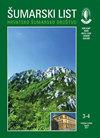土耳其常见樟子松(Pinus sylvestris L.)因地理位置和海拔高度的解剖学变化
IF 0.4
4区 农林科学
Q4 FORESTRY
引用次数: 0
摘要
本研究对土耳其的8个苏格兰松种群进行了研究,探讨了不同生境和海拔带对针叶解剖特征的影响。使用光学显微镜检查了属于64个个体的496根针头,目的是对16个针头解剖特征的变异性进行评分。方差分析显示,8个种群的针头厚度、针头宽度、树脂管数量、树脂管直径、中心圆柱体宽度、中心圆柱体厚度、内皮细胞数量、内皮层宽度和内皮层厚度因生境区域而异。然而,在所检查的人群中,只有树脂管直径、内皮层宽度和内皮层厚度根据海拔梯度而有显著差异。聚类分析显示,Bolu Aladağ和Ardahan Yalnızçam种群之间的相似性最大,根据针头的解剖特征,最可区分的种群是Giresun Espiye种群。尽管主成分分析表明,针的宽度、中心筒的宽度、针的厚度和中心筒的厚度对分布在土耳其的苏格兰松种群的划界影响最大,但判别分析并没有根据针的解剖特征来区分所检查的种群。本文章由计算机程序翻译,如有差异,请以英文原文为准。
Varijacije u anatomiji iglica običnog bora (Pinus sylvestris L.) s obzirom na staništa i nadmorsku visinu u Turskoj
In this study, eight Scots pine populations from Turkiye were studied to explore the influence of different habitats and altitudinal zones on the needle anatomical traits. A total of 496 needles belonging to 64 individuals were examined using light microscopy with the aim to score variability of sixteen needle anatomical traits. Variance analysis showed significant differences in needle thickness, needle width, resin canal number, resin canal diameter, central cylinder width, central cylinder thickness, endodermis cell number, endodermis width and endodermis thickness of eight populations depending on habitat zones. However, only resin canal diameter, endodermis width and endodermis thickness differ significantly in examined populations depending on altitudinal gradients. Cluster analysis showed the greatest similarities between the Bolu-Aladağ and Ardahan-Yalnızçam populations, and the most distinguishable population was the Giresun-Espiye population based on the anatomical characteristics of the needles. Although principal component analysis showed that needle width, central cylinder width, needle thickness, and central cylinder thickness had the greatest influence on the delimitation of Scots pine populations distributed in Turkiye, discrimination analysis did not separate the examined populations depending on the anatomical characteristics of the needles.
求助全文
通过发布文献求助,成功后即可免费获取论文全文。
去求助
来源期刊

Sumarski List
FORESTRY-
CiteScore
0.90
自引率
20.00%
发文量
32
审稿时长
>12 weeks
期刊介绍:
Forestry Journal publishes scientific and specialist articles from the fields of forestry, forestry-related scientific branches, nature protection and wildlife management.
 求助内容:
求助内容: 应助结果提醒方式:
应助结果提醒方式:


